











|
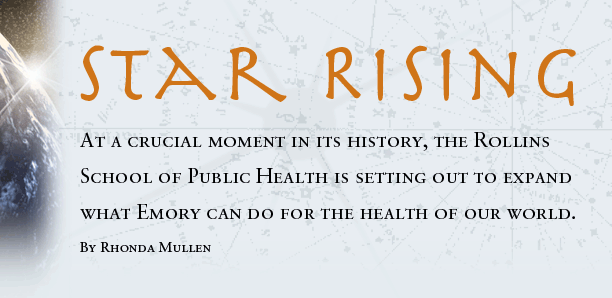 |
| |
 |
|
 |
 he
formation of a school of public health at Emory was inevitable,
says former University President Jim Laney. An ethicist by training,
Laney saw the benefits of such a school to work toward the larger
public good. “It wasn’t a question of whether we should
do it but rather figuring out the means,” he says. he
formation of a school of public health at Emory was inevitable,
says former University President Jim Laney. An ethicist by training,
Laney saw the benefits of such a school to work toward the larger
public good. “It wasn’t a question of whether we should
do it but rather figuring out the means,” he says.
Early advocates such as Eugene Gangarosa,
Connie Conrad, Tom Sellers, and others had built a core of community
health classes in Emory’s medical school into an accredited
graduate public health program by the mid-1970s. Talk began on campus
of taking it further to a school.
“Everyone said we should have
a school of public health because there was a constellation of stars
gathered here.” The brightest star in Atlanta’s galaxy
was the Centers for Disease Control and Prevention (CDC).
It was no accident that CDC was adjacent
to Emory. Atlanta philanthropist Robert W. Woodruff and President
Dwight D. Eisenhower had brokered a deal during the Eisenhower presidency
to transfer what was then known as the Communicable Diseases Center
to land that Woodruff donated to the federal government. Woodruff
had seen firsthand how a public health intervention improved the
lives of workers on his farm, Ichauway, in South Georgia, helping
them avoid the ravages of malaria that was rampant in the 1930s
and 1940s South, and he wanted a strong public health presence in
Atlanta.
Many of the CDC staff offered to teach
at Emory. “We had a fine community health program in the medical
school,” says Laney, “but nothing that would enable
a four-engine jet like CDC to tie into.”
The opportunity to move the program forward came through Robert
and George Woodruff’s historic gift to Emory University in
1979. The gift not only established a solid endowment for Emory
but also enabled University administrators to create what functioned
as an in-house foundation for new initiatives. One of the items
high on that strategic wish list was a school of public health.
Laney gives credit to Woodruff Health
Sciences Center leader Charles Hatcher for convincing the medical
school it was in their best interest to support the school. “People
in the medical school had different priorities,” says Hatcher,
“and there was only so much money. Should we put it in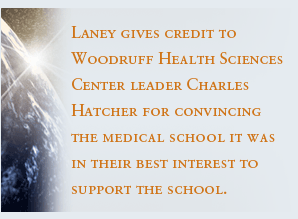 molecular biology or water purification? Both were important. It
wasn’t fair for public health scientists to compete against
medical researchers for funds. They needed a stand-alone school.”
molecular biology or water purification? Both were important. It
wasn’t fair for public health scientists to compete against
medical researchers for funds. They needed a stand-alone school.”
Emory trustees agreed, and in 1990,
they voted to establish Emory’s first new school in 72 years.
Ray Greenberg, chairman of the Departments of Biostatistics and
Epidemiology in the medical school, became the founding dean of
this new school. When the American Cancer Society relocated its
national headquarters from New York to Atlanta in 1989, Hatcher
found a place to house the new school. The ACS agreed to add one
floor to its building, which it then leased to Emory for the School
of Public Health for five years. Hatcher knew his space solution
was only temporary. “I was sawing off the limb on which I
sat,” he says.
However, it didn’t take long for a
permanent home to materialize. Business entrepreneur and Emory supporter
O. Wayne Rollins immediately grasped the vision that public health
offered, according to Laney, and was interested in being a part
of the new venture. Even when Rollins died unexpectedly in 1991,
his family upheld that vision and has since continued to support
the school that is named for them. “The gifts from the Rollins
family meant a lot more than a building,” says Executive Associate
Dean Richard Levinson. “It gave us a presence.”
Associate Dean Kathy Miner, who has
been intimately involved with public health at Emory for more than
30 years as a student, faculty member, and administrator, stays
true to her former career as a secondary school science teacher
when she summarizes the school’s development. “It was
like a ball rolling down a hill. Occasionally it would meet some
resistance, and we had to give it a push, but once it started going,
there was no stopping it.” |
 |
| |
 |
|
 |
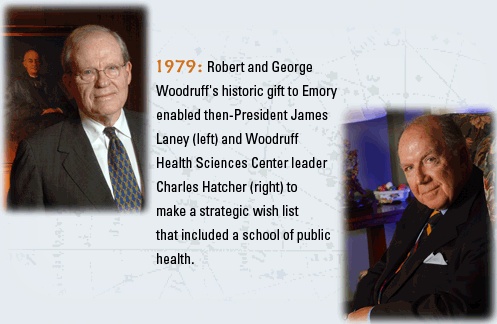 |
 |
| |
 |
|
 |
Operating
on a new level |
|
| |
 |
|
 |
When
James Curran arrived at Emory in 1995 to become the second dean
of the Rollins School of Public Health, he touted it as the youngest
kid on the campus block. In the 10 years since, Curran has a different
message.
“Emory’s public health
program has always promised and delivered quality,” says Curran.
“But we’ve gone from a time of proving ourselves, of
earning respect on campus and in the public health cosmos, to being
a valued partner. The reputation of the school has continued to
grow, and this high quality has enhanced the value of the degree.
The performance of our alumni around the world also has helped increase
our reputation.”
The RSPH is now an established leader
on campus and the third largest school in faculty size and second
in research dollars. It has brought international experts in AIDS,
infectious diseases, nutrition, international health, and cancer
prevention to its faculty, and it boasts one of the most global
faculty and student bodies at Emory. In the past 10 years, it has
added more than 2,600 graduates to its rolls, with those alumni
spreading throughout the world to have an impact on health. It attracts
some of the brightest public health students from 200 countries
and throughout the United States. The RSPH has worked continuously
to strengthen its relationship with public health partners not only
throughout the University but also in Atlanta, collaborating to
make the most of combined resources for public health.
Whereas Greenberg brought youthful
energy and tremendous growth to a new school during his tenure,
adding 50 faculty members by 1995, Curran has become for many the
defining dean of the RSPH. “He is a marquee leader,”
says Levinson. “Jim’s light shines quite brightly, and
that halo extends to the school.”
Curran, who had served as CDC’s
AIDS czar and as U.S. Assistant Surgeon General, further bonded
connections between the school and the CDC. RSPH students intern
at the agency and go on to work there after graduation. The school’s
faculty collaborate with the federal agency on joint research projects
in environmental health, HIV/AIDS prevention, water safety, and
other areas. CDC faculty regularly teach in RSPH classrooms, and
many have joined the RSPH faculty upon leaving CDC. |
 |
| |
 |
|
 |
Expanding
on early strengths |
|
| |
 |
|
 |
For
example, CDC epidemiologist Phil Brachman set up CDC’s first
field epidemiology training program in Thailand and began teaching
in Emory’s MPH program in the 1980s. He joined the faculty
full-time when he retired from CDC. His first office at Emory—a
trailer he shared with Miner—lacked a bathroom, but in the
years since, his office has improved as the classes he teaches in
international health have become part of one of the largest departments
at RSPH.
“From the beginning, one of
our strengths was internationalism,” says Brachman, who still
uses the coffee pot from his trailer days. Many RSPH faculty have
experience overseas, and they bring their networks to students.
Endowed scholarships from Eugene Gangarosa, the Hubert Family Foundation,
and William Foege support students who pursue global field experiences.
Recently, Richard Hubert further solidified the Hubert Foundation’s
commitment to global health by adding to multiple gifts totaling
more than $10 million to name the department. The students themselves
contribute travel support to global fieldwork through sale of foods
and a yearly calendar that features photos from these research trips.
Brachman says the presence of the
Hubert H. Humphrey and Edmund Muskie fellowship programs at the
RSPH are a valuable resource to its global health program. These
international scholarship programs bring mid-career professionals
from developing countries to study public health in the United States.
“These fellows mentor our students and bring connections and
contacts with activities overseas to our classrooms,” he says. |
 |
| |
 |
|
 |
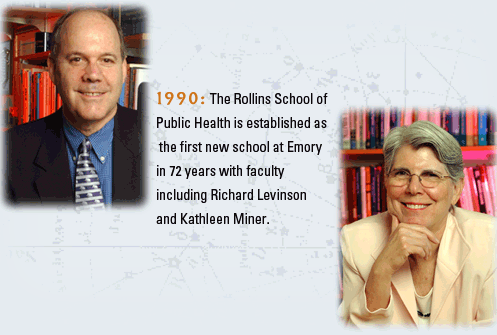 |
 |
| |
 |
|
 |
Community
connections |
|
| |
 |
|
 |
The
RSPH’s strong emphasis on the practice of public health in
communities functions like a gravitational pull for students. “The
RSPH gives students the skills to make a difference,” says
longtime global health professor Stan Foster. “We’re
the best at that.”
Foster entered in the second class
of the early Emory community health program, which he admits took
him seven years to complete. Every time he’d get close to
finishing the required course work, he would ship off to remote
locations to deal with a new disease (Ebola), a disaster (the invasion
of Lebanon), or CDC/USAID’s Child Health Programs in Africa.
He began teaching as an adjunct faculty member in the public health
program in the 1980s and has been a perennial favorite of students,
who have voted him professor of the year. Foster’s classes
of 20 to 30 students in the 1980s now fill 90 seats in a seminar
room.
His popularity comes in part from
his active involvement in his students’ course work during
their first year and in directing them to firsthand experiences
in the community. In his recent spring course studying a pastoral
population in rural Ethiopia, Lynn Sibley, a nursing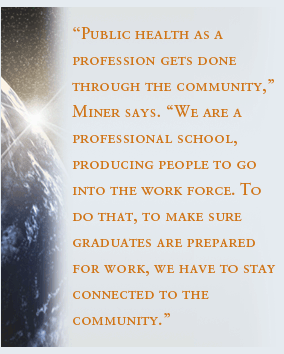 school faculty member with a PhD in anthropology and training as
a nurse midwife, shared her experience of teaching lifesaving skills
to the study population, where up to 10% of women lose their lives
to maternal complications over seven to 10 pregnancies. That class
visit led to one of Foster’s students traveling this summer
to Ethiopia to produce a video documentary on village women acting
out deliveries to teach the community lifesaving skills.
school faculty member with a PhD in anthropology and training as
a nurse midwife, shared her experience of teaching lifesaving skills
to the study population, where up to 10% of women lose their lives
to maternal complications over seven to 10 pregnancies. That class
visit led to one of Foster’s students traveling this summer
to Ethiopia to produce a video documentary on village women acting
out deliveries to teach the community lifesaving skills.
Kathy Miner, one of the first faculty
members in behavioral sciences and health education, also testifies
to the importance of connecting students to the community. In 1997,
she became associate dean and director of the office of Applied
Public Health, which was established to nurture the strong connections
between public health education and practice. She believes the best
learning places instruction alongside actual practice with community
agencies. She wants to prepare graduates to be problem solvers in
action, to work with others on solutions that involve entire communities.
“Public health as a profession
gets done through the community,” she says. “We are
a professional school, producing people to go into the work force,
and to do that, to make sure graduates are prepared for work, we
have to stay connected to the community.”
Throughout her career at Emory, Miner
and her colleagues have spent a lot of energy envisioning what the
school could be in the future. “We’d say, ‘What
we’re doing now is good, but we could be better.’”
|
 |
| |
 |
|
 |
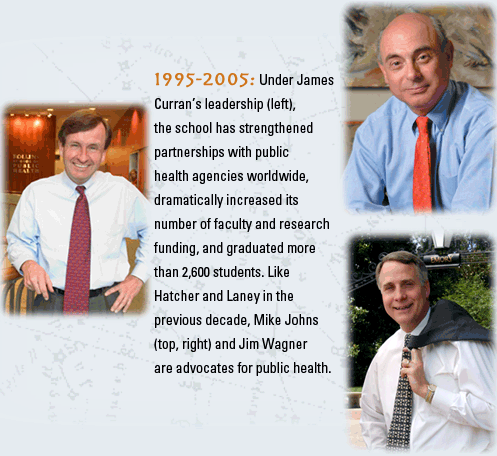 |
 |
| |
 |
|
 |
Destination
Public Health |
|
| |
 |
|
 |
That
focus on the future, on making good things better, is as pervasive
on the Emory campus now as it was in the days following the Woodruff
gift. Emory President James Wagner is leading the campus in defining
a vision of what Emory can accomplish in the future. A recently
crafted mission statement calls for Emory to become a destination
university, one that is inquiry-driven, distinctive for its ethical
commitment, and working for positive transformation in the world.
“The RSPH evokes qualities of engagement and commitment, of
global awareness and connectivity, of justice and service, that
resonate across the University and have become part of how we think
of ourselves and how we strive to behave as an institution,”
he says.
Michael Johns, executive vice president
for health affairs and CEO of the Woodruff Health Sciences Center,
has unveiled Vision 2012, which challenges the Woodruff Health Sciences
Center to become one of the world’s top 10 academic health
centers in the next seven years. The goal is to create a new model
for health and healing, with greater interdisciplinary collaboration
among all the health professions and continuous implementation of
findings from research on patient outcomes. At the most basic level,
the goal is to make a measurable impact on the population’s
health and to serve the health needs of Georgia, the region, the
nation, and other countries around the world. Spreading good health
starts locally, and the center seeks to be the best citizen in metropolitan
Atlanta by being involved with civic projects at all levels.
The RSPH will play a major role in
helping the University and Health Sciences Center fulfill the goals
of reaching beyond the ivory tower to effect a greater good in society.
For starters, the school is already fully engaged with the community,
both locally and globally, and is a cornerstone of global health
at Emory. “Every health professional ought to be versed in
global health just as every citizen ought to be versed in global
issues today,” says Curran. “During my lifetime, the
world has gotten even smaller, and the challenges for people are
not bounded by countries. Our interconnectedness demands that we
pay attention to our neighbor’s needs.”
Public health also is fundamental
to the success of the Health Sciences Center’s emphasis on
developing strength in predictive health, according to Curran. “The
journey of basic science discoveries to the community, whether the
development of mammograms or a new test to screen for prostate cancer,
requires public health researchers and practitioners to ask the
questions: ‘Does the test work? Are we reaching the right
population to be effective? Is the treatment affordable?’”
Public health research, particularly in transitional areas of epidemiology,
outcomes research, behavioral sciences, health education, health
literacy, and health economics, is a necessary bridge in translating
bench science to patient care.
The RSPH is setting its sights on
becoming one of the top five schools of public health in the world
in the next decade. To accomplish that goal, the school needs to
increase its faculty by 30%, to double its research base, to double
the number of doctoral students, and to substantially increase scholarship
dollars.
One immediate hurdle is lack of space.
As in the days preceding its founding, public health now is spread
across campus. The need for a larger headquarters is critical and
immediate. Global health and other departments are actively recruiting
new faculty members, and when those people are hired, they will
need offices and research space.
Affordability of a private university
education is another challenge facing not only the school but also
academia in general, according to Curran. “Public health graduates
often have a high debt load and enter a career of local or global
service or academia,” says Curran. “Most of our graduates
aren’t seeking their education to make large amounts of money.
We have to ensure they can pursue their chosen careers without extensive
debt by increasing our scholarship funds.”
In addition to an increase in scholarships,
RSPH has plans to grow its faculty in key areas: infectious diseases,
safe water, worldwide nutrition, and chronic diseases. The school
especially needs more endowed chairs to increase the number of faculty
without additional leveraging of limited funds. The school is partnering
with other divisions across Emory to jointly recruit and hire. It
hopes to endow 10 to 15 professorships by 2010. |
 |
| |
 |
|
 |
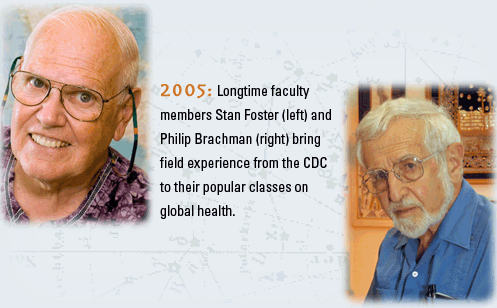 |
 |
| |
 |
|
 |
Higher
expectations |
|
| |
 |
|
 |
In
only a relatively short history of 15 years, the RSPH has turned
the vision of early public health advocates at Emory into a reality.
“I can honestly say we’re among the better schools of
public health,” says Levinson. “We get better students
than most schools, and we give them better training. Our faculty
are highly regarded and, in fact, are being recruited by other places,
which is a good measure of how we’re doing. We are being watched
as a model. I’d say the school is a rising star.”
The recent accreditation of the RSPH
through 2012 by the Council of Education for Public Health confirms
that. The seven-year accreditation was the maximum available for
schools of public health, and the council’s report came with
high praise of the school’s progress.
Recent rankings also validate its status. In 2004, the RSPH ranked
10th among all U.S. schools of public health in attracting NIH funding,
up from 12th the previous year. The $20.8 million in 2004 funding
from NIH marked a 37% increase from the 2003 amount of $15.2 million.
Charles Hatcher is not surprised by
these rankings. “I had an idea the school would be successful,”
he says, “but it has been more successful, faster than I thought,
than I had any right to expect. In five years, it is in the top
10. I think it will go to 3 or 4.”
Laney, too, puts his support in establishing
the RSPH as one of his most solid accomplishments at Emory. “I
was as certain of the success of the School of Public Health at
Emory as of anything I’d ever done,” says the University
president who went on to serve as the U.S. ambassador to South Korea.
“I had high expectations, and it has exceeded my expectations.
Amazing.” |
 |
| |
 |
|
| |
 |
|
|
|
|
|

